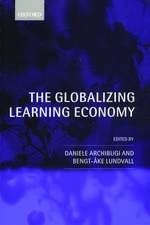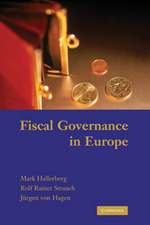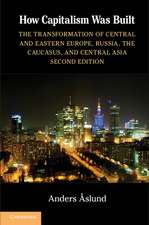The Central and Eastern European Countries and the European Union
Editat de Michael Artis, Anindya Banerjee, Massimiliano Marcellinoen Limba Engleză Paperback – 31 mar 2010
| Toate formatele și edițiile | Preț | Express |
|---|---|---|
| Paperback (1) | 407.69 lei 6-8 săpt. | |
| Cambridge University Press – 31 mar 2010 | 407.69 lei 6-8 săpt. | |
| Hardback (1) | 788.96 lei 6-8 săpt. | |
| Cambridge University Press – 16 mar 2006 | 788.96 lei 6-8 săpt. |
Preț: 407.69 lei
Nou
Puncte Express: 612
Preț estimativ în valută:
78.01€ • 83.42$ • 65.04£
78.01€ • 83.42$ • 65.04£
Carte tipărită la comandă
Livrare economică 17 aprilie-01 mai
Preluare comenzi: 021 569.72.76
Specificații
ISBN-13: 9780521142052
ISBN-10: 0521142059
Pagini: 424
Dimensiuni: 152 x 229 x 24 mm
Greutate: 0.62 kg
Editura: Cambridge University Press
Colecția Cambridge University Press
Locul publicării:Cambridge, United Kingdom
ISBN-10: 0521142059
Pagini: 424
Dimensiuni: 152 x 229 x 24 mm
Greutate: 0.62 kg
Editura: Cambridge University Press
Colecția Cambridge University Press
Locul publicării:Cambridge, United Kingdom
Cuprins
List of figures; List of tables; Notes on contributors; Acknowledgements; Introduction Michael Artis, Anindya Banerjee and Massimiliano Marcellino; 1. New member states: macroeconomic outlook and forecasts Emilio Rossi and Zbyszko Tabernacki; 2. The asymmetric impact of enlargement of old and new Member States: a general equilibrium approach Mohamed Hedi Bchir, Lionel Fontagné and Paolo Zanghieri; 3. Changes in the spatial distribution patterns of European regional activity: the enlargements of the mid-1980s and 2004 Toni Mora, Esther Vayá and Jordi Suriñach; 4. Forecasting macroeconomic variables for the new Member States Anindya Banerjee, Massimiliano Marcellino and Igor Masten; 5. The cyclical experience of the new Member States Michael Artis, Massimiliano Marcellino and Tommaso Proietti; 6. Demand and supply shocks in the new Member States Raúl Ramos and Jordi Suriñach; 7. Monetary transmission in the new Member States Raúl Ramos and Jordi Suriñach; 8. Promoting fiscal restraint in three Central European Member States Emilio Rossi and Zbyszko Tabernacki; 9. Current accounts dynamics in new Members State Paolo Zanghieri; 10. Challenges to banking sector stability in selected new Member States Charles Movit; 11. Infrastructure investments as a tool for regional development policy: lessons from the Spanish evidence Rosina Moreno, Enrique López-Bazo and Manuel Artis; 12. TFP, costs and public infrastructure: an equivocal relationship Eliana La Ferrara and Massimiliano Marcellino; 13. Regional policies after the EU enlargement Michele Boldrin; Index.
Recenzii
Review of the hardback: 'The economic impacts of the recent enlargement of the European Union on both old and new member states have come to the forefront of political debate across Europe. This timely volume brings clear-headed depth to the subject, with its valuable and well-grounded analyses that draw on state-of-the art research by an international team of economists.' Helen Wallace, Director, Robert Schuman Centre for Advanced Studies, European University Institute
Review of the hardback: 'This is a very useful book, containing a wealth of facts and insightful analysis on the economic structure of Central and Eastern European countries. I am sure the book will become standard reference for the policy discussion on how to respond to the challenges that these countries are facing with membership of the European Union and the European Monetary Union.' Lucrezia Reichlin, Director General Research, European Central Bank
Review of the hardback: 'This book presents a thorough analysis of some of the most pertinent issues in the process of economic integration of the recently acceded Member States. It is a very timely and welcome contribution in a research area of high policy relevance.' Juergen Kroeger, European Commission
Review of the hardback: 'This is a very useful book, containing a wealth of facts and insightful analysis on the economic structure of Central and Eastern European countries. I am sure the book will become standard reference for the policy discussion on how to respond to the challenges that these countries are facing with membership of the European Union and the European Monetary Union.' Lucrezia Reichlin, Director General Research, European Central Bank
Review of the hardback: 'This book presents a thorough analysis of some of the most pertinent issues in the process of economic integration of the recently acceded Member States. It is a very timely and welcome contribution in a research area of high policy relevance.' Juergen Kroeger, European Commission
Descriere
Analyses the likely economic effects of the ten Central and Eastern European countries entering the European Union in 2004.













